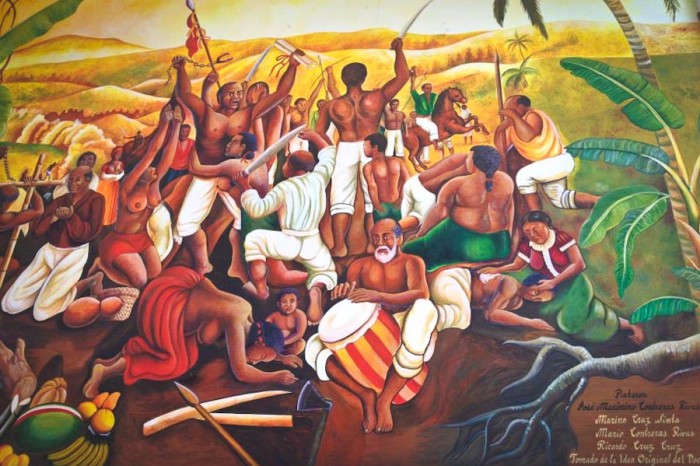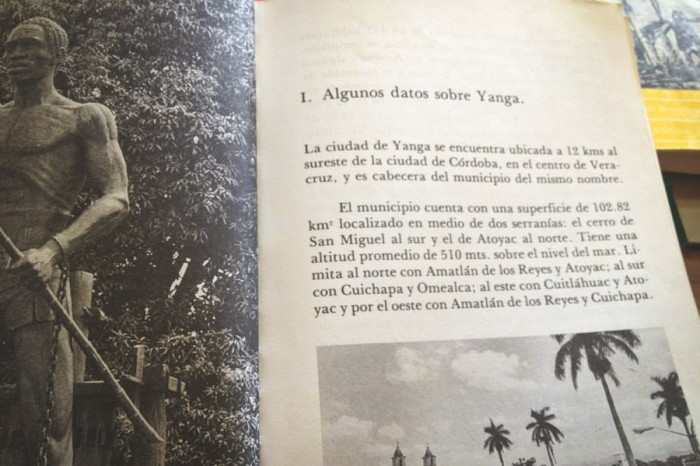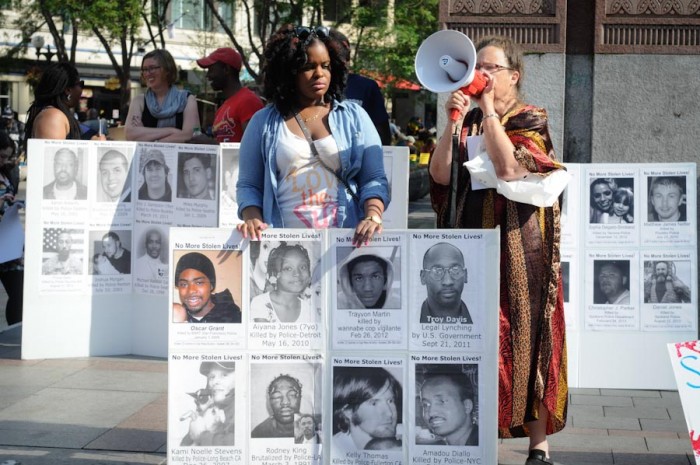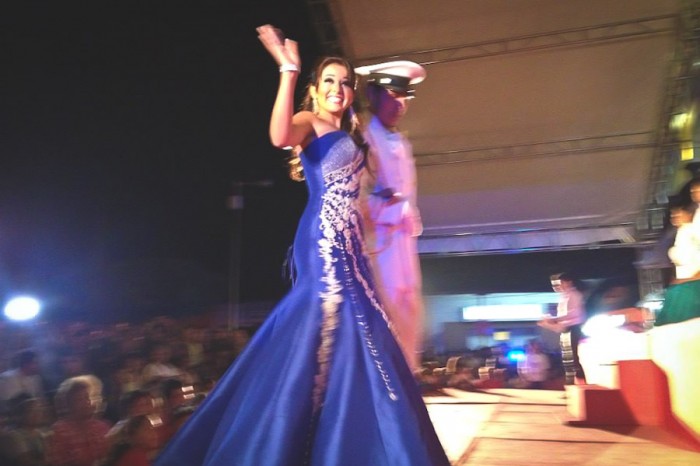
No one ever just calls it “Yanga.” The tagline “the first free town in the Americas” is as much a part of the identity of this place as the myth of the prince turned rebel slave whose name the town bears. From the moment you cross into town you will be reminded of its illustrious history as a haven for 400 black slaves who won their freedom in a battle against the Spanish in 1609.
The walls of the public buildings and even some cafes are lined with black art. Black rag dolls and quazi African trinkets, masks and sculptures pack the shelves of corner stores and markets. The slave trade may be long over, but the commodification of black images is commonplace.
During my 16 day trip to Mexico, I visited Yanga twice, once to see the sights and the second time to attend the annual Carnaval Afro-Mexicano. My goal was to explore Afro-Mexican identity, retracing the path of the black diaspora through the history of the state of Veracruz and searching for understanding of the present black culture.
You can taste the African heritage all around Veracruz, in the spicy regional cuisine. You can hear it in the lyrics and beat of the live music played and danced to each afternoon in the Zócalo — the main square of the historic district in Puerto de Veracruz. I didn’t go a day without hearing songs about la negra, la morenita, the black woman, the little dark one.
And yet, everywhere I went, my presence was met with long inquisitive stares and followed up with questions about my origins. No one mistook me for Mexican… Cuban or Dominican perhaps, but not Veracruzana. And yet it was plain that the diaspora had marked this area. So what happened to all the black people?
I held out hope for Yanga. All the Mexicans I met assured me that black people lived there. I arrived in town with no real plan. By accident I ended up in the mayor’s office. Upon discovering I was a foreigner wanting to learn more about Yanga, Mayor Gerson Morales Villanos (who everyone refers to as “El Presidente”) dispatched Lubin, one of his aides and Andrés, the town librarian to commandeer a municipal vehicle.
I was escorted to the three main tourist sights: the statue of “El Negro” set against a beautiful mural depicting the rebellion, the museum in Palmillas, and the ruins of the haciendas built during the height of the slave trade.
Since 1932 — when the town formerly known as San Lorenzo de los Negritos was renamed in an attempt to solidify Yanga’s place as the black Mexican folk icon — tourists from across the African diaspora have made the same pilgrimage. The librarian made a point to show me picture of a delegation of dignitaries who came all the way from Ghana.

But it was at the Palmillas Museum just outside of Yanga, in a fascinating one-on-one with the director, archeologist and researcher, Fernando Miranda Flores, that it was finally confirmed for me the thing no other Mexican seemed to want to say directly.
“The group here lost their culture. Some traditions remain in terms of certain dishes and wood working customs, but now there is little left.”
I settled in to hear once more the legend behind the pithy tagline. While it was Francisco de la Matoza who allegedly led the armed rebellion (since Yanga would have been 55 at the time and too old to fight), Yanga (or possibly “N’Ganga”) was said to be the man with the plan.
The history gets murky and is fraught with fascinating mysteries, but the indisputable result was that Yanga and his band of slaves caused so much disruption to the trade of slaves and sugar, that the Spanish government ultimately found it more profitable to grant them their freedom.
Freedom is a relative term. Citizens of the town that would later become Yanga could not have alcohol or weapons. They were also not allowed to have any interactions with the other black people who would arrive in Veracruz, because those people would come as slaves and freedom was (and is still) considered a highly contagious ideal. It was more like reservation than a town.
With no access to new black people, the population of Yanga intermarried with the local indigenous people. Eventually the women of Yanga became disgruntled with the town and most left to live in the Port of Veracruz where they found employment, often as domestic help and sometimes as prostitutes.
Of course that was just the story of one group of people there were those who came as slaves and were not granted freedom and those who came much later during the building of the railroad. After finishing up at the museum, Lubin and Andres took me to Mataclara to meet Florentino Virgen Castro, a musician and the first self-identified Afro-Mexican that I had the privilege to meet.
Louis Armstrong played in the background as he received us into his living room a sepia hued space with framed photos spilling family history across the walls. His grandfather was from Martinique and came in the group of railroad workers. Over the course of the afternoon we spoke of his life and his family, the Yoruba religious traditions they had managed to retain despite the Catholic imposition that is present even in the name he carries. Virgen Castro expressed pride in his identity as a black Mexican and pride in persevering despite discrimination.
He took us to meet his sister and aunt, two black women who wore their hair natural and made sarcastic comments about all the people who had come from other countries looking for Afro-Mexicans.
“Aqui estamos,” We’re here, they said casually, but in their words I recognized the underpinning act of revolution. Throughout my trip I felt as though I were chasing ghosts, as though Mexico itself had eaten what was black and left only music and stories. We’re here, they told me, despite all odds, in the face of adversity, after all this time.
At night I returned to my hotel room and flipped on CNN. I found myself glued to the events unfolding in Ferguson, Missouri. Mike Brown. Trayvon Martin. Eric Garner. Amadou Dialo. I feel ashamed when I start to forget their names, but the list goes on and on. It is too much weight to carry, too much grief, too much rage condensing like an unending storm always brewing in our collective consciousness.

I want to remember their names and stories because I am afraid that if I don’t they will disappear, but every memory of injustice, of how black lives have gone from being bought and sold to having little to no value at all, is another way of disappearing me.
How many times can we relive this same tragedy and not feel like a part of ourselves was killed as well? This is the unspoken war, no longer North vs. South, this is the war of the U.S. against black people. It’s a silent genocide and there is no winning.
In this so called “post-racial” American since Obama’s second term began it seems like all the covert racists have come out of the closet. Every few minutes there is more news of white supremacist rallies or, more anecdotally, friends being called “nigger” or in general white people just losing their damn minds.
The fear is palpable. What else but fear can explain why a trained officer would need six bullets to subdue an unarmed teenager who had already surrendered?
I returned to Yanga wondering if this was how its former citizens had felt, hemmed in by Spanish law, not allowed any weapons except for a locked shed containing guns that could be used in case of pirates. Their very existence dictated by their former captors, a balancing act: Free, but only so free. Human, but only so human. Ultimately, in preserving their freedom their descendants lost the very culture and heritage they fought to save.
After an hour and a half of Mexican folkloric dancing (which is pretty much like river dance with lacy costumes), I sat in my plastic chair, sipping a warm corona courtesy of the mayor’s aide, and watched four white Mexicans be crowned queens of the Afro-Mexican Carnival while the Orizaba symphony butchered a tribute to the Beatles.
In the crowd of the hundreds of people who attended I was one of a handful of black faces. The only act of the evening that had anything to do with blackness was Santo Negro y Las Chicas de Angel, a west African drumming troupe who played and danced for about a half hour, with no explanation of which country they hailed from or what the significance of the music was.

On my cab ride back to my hotel in Cordoba I found myself contemplating cultural erasure. Identity is a complex nuanced creation built on family, how you are taught to see yourself, and how other see and respond to you.
While the myth of the U.S. is that we are all a part of a melting pot, I think the more apt metaphor is that of a salad bowl, collectively forming an American identity from very unique cultural components. What I found in Mexico was the true melting pot, a soup brewed from black, Spanish, and indigenous cultures, now seamlessly blended to create one overarching Mexican identity.
While on my trip I met a white couple from the U.S. who have lived in Mexico for ten years. The husband shared his observations about the cultural homogeneity. He was excited about it — as though this were the perfect solution to all of the racial issues in the U.S. As though all the mixing were voluntary and not a survival strategy on the part of black and indigenous people.
“People get along,” he said, vastly oversimplifying the dynamics and ignoring all the sacrifices made in the creation of this so-called beautiful unity.
In the U.S. we have managed to maintain distinct cultural identities. But society’s violent response to our identity as black people continuously puts us in danger.
So what’s worse, to lose your life because you are seen as a threat, or to give up your identity to no longer be threatening?


To lose your life definitely! Identity is incredibly personal and hard to mandate.
Wonderful piece!!! I have always been interested in other cultures and then the “Afro” side of those cultures. In my discussions, I have always used “oatmeal vs. a rich stew” to compare with your soup vs. salad. I always touted the stew, that we should learn to love and respect despite our differences which will help us appreciate each other. As I have gotten older, I believe in opening your mind and heart when it comes to love and life, so in a few generations, we could very well have oatmeal/soup, physically. And this is where the seasoning comes in…… I used to mention, how bland and colorless oatmeal was and then I am reminded that my own oatmeal, which is delicious, made with milk and fresh vanilla (not water) and is chock full of colorful fruits and spices.
When you’ve lost so much, your life is the only thing you can hold as yours. That’s why they were able to give their culture and color away, so as not to give them the pleasure of taking their lives too. But also, as a slave, when even your life isn’t yours, what’s there to be taken away? They didn’t feel like losing anything, because they had already lost everything. I wouldn’t give up my identity, but maybe that’s beacause I’m not in the situation they were.
This article is really impressive. I only hope the case in the US doesn’t be the same as in other places.